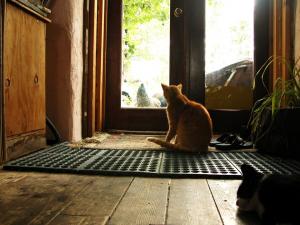Looking for design inspiration? Browse our curated collections!
December 13th, 2014 - 12:27 PM

What would our health care system include to foster luxurious, innovative, and precise mental health treatments?
The term horizontal hostility was coined to discuss a mental health phenomena that plagues the nursing profession. Horizontal hostility is the subtlety of behaviors that rub off between groups of co-workers, family, or peers. Communication does not entitle an abuse of power, but in circumstances
of stress (like those in hospitals) there is a noticeable shift of negative emotion transferred from one person to another. I am reminded of a time spent in the country where the peacocks would get chased by the dog. In retaliation, the birds began to chase the cats. The emotional abuse that nursing
professionals experience with 'burn-out' resembles this cyclic peacock chase.
Abusive relationships have an imbalance of power, whether or not the relationship is personal, or professional. Horizontal hostility occurs because there is a lack of awareness in the bully's reactions. The peacocks have forgotten their victimhood. They have taken the role of bully with regard to the
cats. Grounding awareness in the current moment, takes practice. New behaviors of assertiveness can feel impossible when there is an entrenched depletion of self-worth. The simple behavior of awareness deadens the effects of horizontal violence. Contemplation provides the capacity to elevate thoughts away from this fight or flight survival framework.
Horizontal hostility defines a victim role; someone who is oppressed. The drama triangle is the combined roles of the perpetrator (bully), victim, and a rescuer. These three roles are interchangeable. The rescuer is a common role, in which helping professionals identify. Although, often victims will
believe that they are a portraying the rescuer role. A perpetrator will perceive themselves as the victim, but in reflection, adjust their perspective, and witness their behavior as that of an undercover bully. A hostile reaction to any perceived threat blinds the perpetrator into behaving as if in the victim
role. The result being a revolving drama triangle. Examples of the emotional effects of horizontal hostility are anger, irritability, decreased self-esteem, self-doubt, and feelings of being unable to meet expectations. Some cases of horizontal hostility depress immune function, a direct consequence of
bullying that is physical.
The bullying in our social interactions leads to strained relationships with partners and friends. Depression and stress from simply witnessing verbal abuse brings consequences both physical and mental. Physical and psychological responses to peer to peer hostility include substance abuse, or
over-eating. Drama triangle behavior is perpetuated by low interpersonal/emotional support, or lack of interdiction by witnesses. This spiral of negative behavior can be blocked by actions that sponsor direct communication about negative behaviors. It is simply this awareness which allows the victim to
take responsibility, to assert against both negative body language and verbal abuse. The freeze and leave method (as it is part of the victim's framework of survival) serves only to free oneself from the drama triangle. It is the reflection, the contemplative moment that allows each of us to renegotiate
our experience. With contemplation, we are able to communicate succinctly our true feelings.
The larger picture of happiness and respect is a choice. Could focusing inward, using contemplative practice to break the drama triangle help redefine our relationships? Are we all victims? At some point, we have all witnessed an interaction that made our psyche cringe. Maybe it was a visual image
in a magazine, or something we witnessed in our community. More than likely it was on the television, which sponsors a fear-based mentality. Allow for a brief moment, your mind to wander off into the void of reactionary behaviors that fill our days. How much of our day is spent in conscious
consideration of how the expectations of others feed our own choices? Classically, we know communication has relevance in the protection of basic needs, safety, and the need for attention. Consider that the fight or flight response is the starting point for anyone ever having experienced
emotional abuse (horizontal hostility). Horizontal hostility appears as a shifting freeze and deny behavior. A victim freezes and brings the abuse inside. Turning the assault onto their senses for stability. The abuse then becomes the framework for our cognitive agenda. What other tools can we consciously add to our survival tools of fight, flight; and the possibility of freeze and leave?
The nurses who care for us in times of weakness deserve the luxury of healing, progressive work environments. There is, in fact, a remedy to this problem of horizontal hostility. Recognition of emotional abuse as a real physical threat to health, especially in the nursing professions is the foundational centerpiece to a culture of care. The use of overt and covert tactics to intimidate, blame, or criticize are not a social norm. Adults communicate about their problems without covert tactics like a refusal to participate, whining, or fabricating offenses. The immediate reference to end this type of reaction must be established by either a participant, a witness, or more likely the person in charge.
Comments
There are no comments on this blog. Click here to post the first comment.